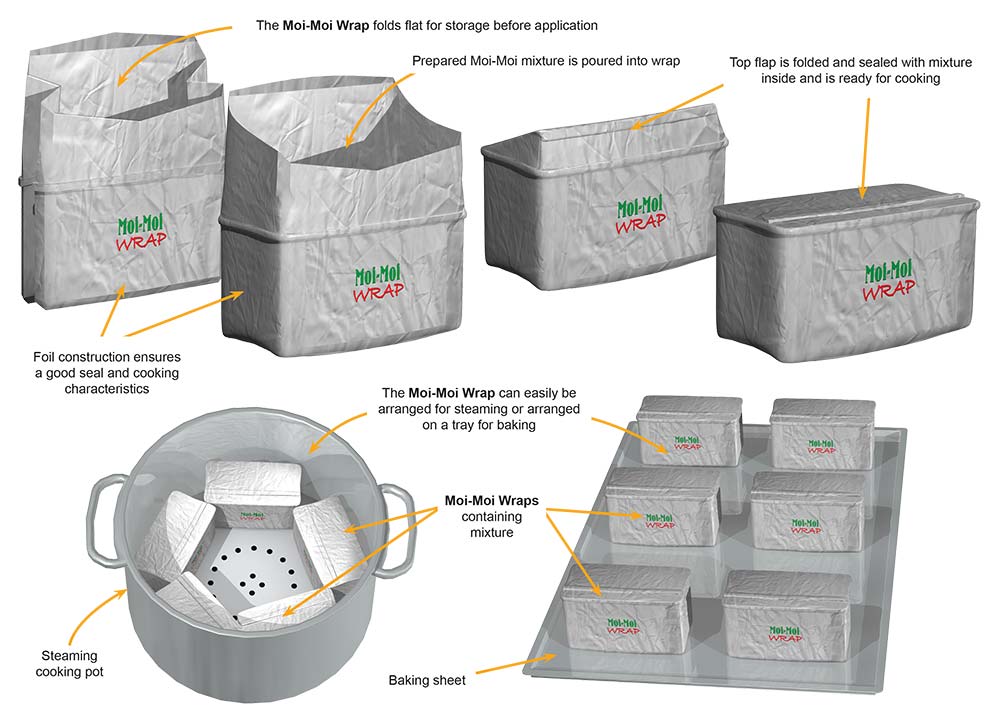
Moi-Moi Wrap
DESCRIPTION:
The name of the country of Nigeria is taken from the Niger river that serves as an important transportation route. The Niger river not only serves as a vital transportation course for the country it is also an excellent source for fish that is consumed by the people of the country for daily subsistence as well as for entrepreneurs selling fish at markets. The river is also an excellent source of water for irrigation of crops.
Nigeria is located on the west coast of Africa at the inner corner of the Gulf of Guinea on the Atlantic Ocean. The land area of the country is approximately twice the land mass of the state of California in the United States. Mangrove forests line the coast of Nigeria and beyond the Mangroves exist the wide tropical forests of the country. The eastern side of the country features the Shebshi Mountains and at the extreme northern section lies the border of the Sahara desert.
There are hundreds of tribes in the country of Nigeria. There are three major tribes from which the majority of people of Nigeria originate. These majority tribes are Igbo, Hausa, and Yorba. Each tribe has their myths, legends, and culture consisting of festivals, and traditions that are unique to their respective tribe. The Igbos celebrate festivals including Iwaji (new yam festival). Other various towns and tribes celebrate their customs and festivals according to who they are. Awka town which is also the capital of the Anambra state celebrates the Imo awka. All of the town and tribes of Nigeria celebrate festivals, and the food plays a large part in the celebrations. Nigeria has such a variety of people and cultures that it is difficult to select a particular national dish. Different foods are connected directly to the seasonal availability and the dishes served will reflect the particular season that they are accessible.
The Nigerian steamed bean pudding known as Moi-Moi is enjoyed as a staple food for many people in Nigeria as well as around the world. Made from a mixture of washed and peeled black-eyed peas, onions and fresh ground peppers. It is a protein-rich food and is a traditional staple in Nigeria. As with any recipe, people will add their personal touches with different ingredients and cooking techniques. Moi-Moi is traditionally cooked wrapped in leaves but modern times being what they are the cooking in the leaves is commonly omitted, and the preparation of the dish is often made with foil or plastic bags instead. The use of plastic for steaming Moi-Moi is not the preferred method and foil has proved to be superior to plastic as a way to prepare the dish for cooking. Plastic bags will work, but the bags have to be able to stand the heat generated when steaming Moi-Moi. Plastic not intended for cooking can have undesirable results plus there is the chemical composition of the plastic resulting in the possibility of toxic substances entering the food when the plastic is at high temperature.
The Moi-Moi Wra is a unique and innovative product designed to improve the process of creating the dish. The product is a heavy duty foil form that is designed to accommodate the mixture of raw Moi-Moi for cooking. The Moi-Moi Wrap is stored flat and is easily opened to form a receptacle for cooking the mixture. The foil form once expanded and opened up has a foil flap at the top for sealing the container. The prepared Moi-Moi mixture is poured into the container, and the top can be quickly sealed by folding the foil flap. When the mixture is sealed in the Moi-Moi Wrap, the container is ready for cooking by placing in a steamer pot or oven. The Moi-Moi Wrap creates an efficient and hygienic method for preparing the dish and multiple Moi-Moi Wraps are prepared for cooking very quickly. Ideal for large batches of Moi-Moi for commercial operations such as restaurants or any large gatherings. The Moi-Moi Wrap solves many preparation issues with Moi-Moi dishes and presents an efficient and clean process for creating the dish.
SPECIFIC, UNIQUE FUNCTIONS OF INVENTION:
- Folds flat for storage and packaging
- Open easily and quickly to form container
- Constructed of heavy duty foil
- Top flap for sealing container
- Multiple containers can be prepared quickly and easily
- Multiple wraps can fit in a steam pot or oven
- Hygienic and efficient
- Disposable after use
- Great for large gatherings or restaurants
PRODUCT COMPONENT CLARIFICATION:
The “Moi-Moi Wrap” is an innovative cooking product that has been designed to promote easier preparation of the West African staple, Moi-Moi, or steamed bean pudding. The semi-liquid bean pudding mixture is poured into the foil cooking bags, is sealed, and then steamed or baked. The foil enclosure, the “Moi-Moi Wrap” is the ‘new world’ replacement for banana leaves, which are used in the original cooking process. The food-grade, rectangular shaped, heavy-duty foil bag is supplied in packages of 6 or 12 for home use. When the user is ready to cook, the folded flat bags are removed from storage, opened up, filled to the embossed line, and then sealed for cooking. After use, the bags can be rinsed and then recycled.
Currently, the bean pudding is cooked in aluminum foil or plastic wrap. The thin aluminum foil can be punctured during the filling or cooking process, allowing some of the contents to leak out of the cooking package, making a mess. If the plastic wrap is used to make the cooking enclosure, some of the plastic’s carcinogenic chemicals can leach out at the cooking temperatures, which is not healthy for the consumer of the food.
The “Moi-Moi Wrap” resolves most of these problems by providing a food grade, extra heavy-duty, pre-folded and glued bag, into which the semi-liquid bean mixture can be poured or ladled prior to cooking. After filling, the specially shaped flaps are folded over each other and the wrap is sealed, making it ready for cooking. The foil and glued wraps are FDA approved for food preparation and are durable enough to either be steamed or baked for hours without degradation. After cooking, the semi- solid bean block can be removed from the wrap, the wrap rinsed, and then disposed of in the recycle bin. The wrap is easy to use, prepares excellent Moi-Moi, and is easy on the environment when recycled.
- The bags are supplied in one of three sizes, i.e., small medium and large. In parties, the smaller size is often served with rice and salad. In restaurants, the small or medium sizes are served with fish and fried plantain. In most homes, the larger size is employed to serve the whole family.
- The storage and point of purchase boxes are pre-printed and stocked in many different counts per box. Typically, this is 6 or 12 for the family size and 24, 48, and/or 60 for the commercial applications.
How to make Moi-Moi: There are literally hundreds of recipes for Moi-Moi. They are almost all based upon the use of black eyed peas (beans) and are prepared similar to this Nigerian style recipe. (Please note that the recipes can vary widely from region to region and between tribes in Western Africa and through-out the world. This single meal recipe is simply included as an example).
- 2 cups of blackeye peas
- 1/2 can of corned beef
- 1 onion
- 2 fresh tomatoes
- 2 tablespoons of vegetable oil
- Salt to taste
- Pepper to taste
- 3” by 3” by 4” foil enclosure
- Directions: Soak peas in 3 cups of water for 1 hour. Wash off the blackeye and membrane covering and discard. Blend remainder to fine consistency in blender with tomatoes and onion. Blend in vegetable oil and add salt and pepper to taste. Decant from blender to bowl, add bits of corned beef, stir to uniformly incorporate the corned beef, then ladle semi-liquid mixture into the foil enclosure, and seal tightly. Place the foil enclosure in large pot with 2 cups of boiling water. Cover pot with lid and allow to cook for 45 minutes to one hour. Add water to the pot if required. The Moi-Moi will be semi-solid when cooked through.
The foil enclosure: The foil bag is fabricated using 0.0011 to 0.0016 thick aluminum foil. This extra heavy-duty foil is about twice as thick as normal kitchen foil and is very durable, yet conducts heat equally well as the thinner foil. The interior surface of the foil is coated with a very thin food grade, silicone non-stick material that allows the bean block to release well after cooking. This coating and foil have been approved by the FDA as being safe for food preparation and storage use. The flat stock is cut to height, run as flat sheets through the printer, where the UV cured inks are applied to create the logo. As the sheets come out of the printing press, the fill line is embossed into the sheet from the back, and the sheet flows into the folder. The folder applies the food grade adhesive in very specific places, folds the bag (wrap) into an enclosure and presses it shut, making a rectangular watertight bag. After creating the wrap, the machine folds it into the flattened form and stacks 6, 12, 24, 48, or 60 in each bundle, depending upon where it is to be used, i.e., home or commercial restaurants. Then these bundles are transferred into the point-of-sale pre-printed cardboard cartons, which also serve as the storage enclosure in the pantry of the home or restaurant.
- As an option: The wrap does not have to be rectangular, it may be supplied in any one of many various shapes. For example, it can be cylindrical, pyramidal, conical, etc. Each of these shapes will be fabricated similarly to above and be placed in the point-of-sale carton in a flat form.
The Moi-Moi Wrap is designed to be aesthetic and effective in the application. The relative ease of manufacture and the moderately inexpensive components provide good marketability for the manufacturer. The user benefits from improved usefulness, food grade reliability, and a low impact to the environment, which should provide considerable market interest in the product.
The invention is illustrated in the following drawings of the essential points as explained to us in the documentation.

Drawing 1, Block 1: Moi-Moi Wrap – End And Front Views
(1) The product is formed into a sealed bag that will hold the semi-liquid prepared bean mixture and then is capable of being steamed or baked for hours without losing its integrity.
(2) The bag type product is made from extra heavy-duty aluminum foil and is formed into a bag that can be folded and stored for sale in multiples of 6 or 12 per box for home use and 24, 48, or 60 per box for commercial restaurant use.
(3) The bags are also supplied in one of three sizes, i.e., small, medium, and large.
(4) The strong aluminum foil product is coated in the inside surface of the bag with a non- stick silicone based coating that allows the cooked mixture to release from the foil.
(5) The bag folds up flat and can easily be opened to stand on the table for filling after the raw material is poured or ladled into the cavity.
(6) After filling, the bag’s upper flaps are folded in over each other to seal the package for cooking.
(7) After sealing the upper flaps, the bricks of bean mixture are ready to be steamed on the stove top or baked in the oven and the foil bag easily retains the mixture within during the cooking process.
(8) The product’s logo is printed and UV cured on the flat foil prior to gluing and folding, with the logo facing toward the lower flap (front) side of the bag. Moi-Moi Wrap
(9) After cooking, the foil bag can be emptied, rinsed, and then recycled for smelting and re- use in other aluminum products.
(10) The food grade product is supplied in a rectangular outline as shown here, or can be supplied in a cylindrical or almost any other shape that more easily fits in the cookware being used.
Although a single embodiment of the invention has been illustrated in the accompanying drawings and described in the above detailed description, it will be understood that the invention is not limited to the embodiment developed herein, but is capable of numerous rearrangements, modifications, substitutions of parts and elements without departing from the spirit and scope of the invention.
This document has been prepared for the manufacturer’s elucidation. The manufacturer’s decision makers should consider this product for licensing (providing intellectual property protection for their sales of the product in return for a royalty payment for a period of years) or an outright purchase of the patent for a negotiated fee. The inventor and her team are standing by to consider offers for licensing or outright purchase of the patent.


